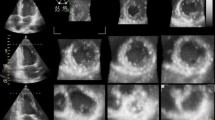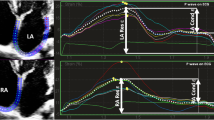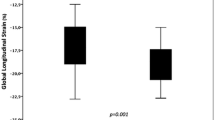Abstract
To analyze left ventricular myocardial deformation and contractile reserve in endurance athletes at rest and during exercise, and their possible correlations with functional capacity. The athlete’s heart in endurance training is characterized by physiologic eccentric remodeling, with left ventricle adaptation at rest and echocardiographic parameters at low end of normality. Assessment of left ventricle systolic function and contractile reserve has an important role in the decision-making and in differential diagnosis with cardiomyopathies. Standard echo, lung ultrasound, left ventricle 2D speckle-tracking strain and myocardial work were performed at rest and during exercise in endurance athletes and in age- and sex-comparable healthy controls. 350 endurance athletes (male sex 58.5%; 31.6 ± 4.2 years) and 150 healthy controls were enrolled. Left ventricular ejection fraction at baseline was comparable between the two groups. Resting left ventricular global longitudinal strain was reduced in endurance athletes (− 18.4 ± 2.6% vs. − 22.4 ± 3.3% in controls; p < 0.01). Myocardial work efficiency did not show significative difference between the two groups. At peak exertion during exercise stress echocardiography, endurance athletes showed better exercise capacity and peak VO2 consumption (58.6 ± 10.2 ml/kg/min vs 38.6 ± 3.3 ml/kg/min in controls, p < 0.0001), associated with a preserved contractile reserve and augmented pulmonary artery systolic pressure. By multivariable analysis myocardial work efficiency at rest was closely related to maximal watts (p < 0.0001), peak VO2, (p < 0.0001), left ventricular E/eʹ (p < 0.001) and number of B-lines (p < 0.001), all measured at peak effort. Myocardial work efficiency shows less load-dependency than global longitudinal strain. Normal resting values of myocardial work efficiency in endurance athletes suggest a physiological remodeling, associated with a better exercise capacity and preserved contractile reserve during physical effort.


Similar content being viewed by others
Abbreviations
- 2D-STE:
-
2D speckle tracking echocardiography
- 3D-STE:
-
3D speckle tracking echocardiography
- BP:
-
Blood pressure
- CMR:
-
Cardiac magnetic resonance
- COV:
-
Coefficient of variation
- CR:
-
Contractile reserve
- CW:
-
Constructive work
- DCM:
-
Dilated cardiomyopathy
- EA:
-
Endurance athletes
- EDV:
-
End-diastolic volume
- ESE:
-
Exercise stress echocardiography
- ESV:
-
End-systolic volume
- GCS:
-
Global circumferential strain
- GLS:
-
Global longitudinal strain
- GRS:
-
Global radial strain
- GWI:
-
Global work index
- HCM:
-
Hypertrophic cardiomyopathy
- IVC:
-
Inferior vena cava
- IVRT:
-
Isovolumic relaxation time
- LAVI:
-
Left atrial volume index
- LV:
-
Left ventricular
- LVEF:
-
Left ventricular ejection fraction
- LVMI:
-
Left ventricular mass index
- MW:
-
Myocardial work
- MWE:
-
Myocardial work efficiency
- MWW:
-
Myocardial wasted work
- PASP:
-
Pulmonary artery systolic pressure
- RAP:
-
Right atrial pressure
- ROC:
-
Receiver operating characteristic
- ROI:
-
Region of interest
- RV:
-
Right ventricular
- RVSP:
-
Right ventricular systolic pressure
- RWT:
-
Relative wall thickness
- TAPSE:
-
Tricuspid annular plane systolic excursion
- TD:
-
Tissue doppler
- TRV:
-
Tricuspid regurgitant velocity
- WW:
-
Wasted work
References
Galderisi M, Cardim N, D’Andrea A et al (2015) The multimodality cardiac imaging approach to the athlete’s heart: an expert consensus of the European Association of Cardiovascular Imaging. Eur Heart J Cardiovasc Imaging 16:353
Lo Iudice F, Petitto M, Ferrone M et al (2017) Determinants of myocardial mechanics in top-level endurance athletes: three-dimensional speckle tracking evaluation. Eur Heart J Cardiovasc Imaging 18(5):549–555
Lancellotti P, Magne J (2013) Stress echocardiography in regurgitant valve disease. Circ. Cardiovasc Imaging 6:840–849
Lang RM, Badano LP (2015) Recommendations for cardiac chamber quantification by echocardiography in adults: an update from the American Society of Echocardiography and the European Association of Cardiovascular Imaging. Eur Heart J Cardiovasc Imaging 16:233–271
D’Andrea A, Bossone E, Radmilovic J et al (2015) (2015) The role of new echocardiographic techniques in athlete’s heart. F1000Res 4:289
Santoro A, Alvino F, Antonelli G et al (2014) Endurance and strength athlete’s heart: analysis of myocardial deformation by speckle tracking echocardiography. J Cardiovasc Ultrasound 22:196–204
D’Andrea A, Limongelli G, Caso P et al (2002) Association between left ventricular structure and cardiac performance during effort in two morphological forms of athlete’s heart. Int J Cardiol 86:177–184
D’Andrea A, Carbone A, Agricola E et al (2019) Predictive value of left ventricular myocardial deformation for left ventricular remodeling in patients with classical low-flow, low-gradient aortic stenosis undergoing transcatheter aortic valve replacement. Jase 32(6):730–736
Pelliccia A, Maron BJ, Spataro A et al (1991) The upper limit of physiologic cardiac hypertrophy in highly trained elite athletes. N Engl J Med 324(5):295–301
Caselli S, Di Paolo FM, Pisicchio C et al (2015) Patterns of left ventricular diastolic function in Olympic athletes. J Am Soc Echocardiogr 28(2):236–244
Cotrim C, Almeida AR, Miranda R et al (2010) Stress-induced intraventricular gradients in symptomatic athletes during upright exercise continuous wave Doppler echocardiography. Am J Cardiol 106(12):1808–1812
Pelliccia A, Culasso F, Di Paolo FM et al (1999) Physiologic left ventricular cavity dilatation in elite athletes. Ann Intern Med 130(1):23–31
Maron BJ (1986) Structural features of the athlete heart as defined by echocardiography. J Am Coll Cardiol 7(1):190–203
Richand V, Lafitte S, Reant P et al (2007) An ultrasound speckle tracking (twodimensional strain) analysis of myocardial deformation in professional soccer players compared with healthy subjects and hypertrophic cardiomyopathy. Am J Cardiol 100(1):128–132
Szauder I, Kovács A, Pavlik G (2015) Comparison of left ventricular mechanics in runners versus bodybuilders using speckle tracking echocardiography. Cardiovasc Ultrasound 13(1):7
Lynsey F, Keith G, David O (2018) Speckle tracking echocardiography for the assessment of the athlete’s heart: is it ready for daily practice? Curr Treat Options Cardiovasc Med 20(10):83
Soullier C, Obert P, Doucende G et al (2012) Exercise response in hypertrophic cardiomyopathy: blunted left ventricular deformational and twisting reserve with altered systolic-diastolic coupling. Circ Cardiovasc Imaging 5(3):324–332
Okada M, Tanaka H, Matsumoto K et al (2012) Subclinical myocardial dysfunction in patients with reverse-remodeled dilated cardiomyopathy. J Am Soc Echocardiogr 25(7):726–732
Pelliccia A, Caselli S, Sharma S et al (2018) European Association of Preventive Cardiology (EAPC) and European Association of Cardiovascular Imaging (EACVI) joint position statement: recommendations for the indication and interpretation of cardiovascular imaging in the evaluation of the athlete's heart. Eur Heart J 39(21):1949–1969
Renuka J, Shantanu S, Susan O, et al. (2019) Myocardial work: a novel index of left ventricular systolic functionin south asian half-marathon runners correlated with echocardiographic and clinical variables. J Am Coll Cardiol 73(9)
Davies CT, Thompson MW (1986) Physiological responses to prolonged exercise in ultramarathon athletes. J Appl Physiol 61(2):611–617
Žiška P, Olasz D, Krčmár M (2016) Functional parameters during the preparation phase among cross-country skiers. Acta Facul Edu Phys Univ Com 56(1):53–65
Millar L, Fernandez G, Dhutia H et al (2016) Exercise echocardiography has a high sensitivity and specificity in differentiating athlete’s heart from dilated cardiomyopathy. Circulation 134:A15662
Stefani L, Toncelli L, Di Tante V et al (2008) Supernormal functional reserve of apical segments in elite soccer players: an ultrasound speckle tracking handgrip stress study. Cardiovasc Ultrasound 6:14
Claessen G, Schnell F, Bogaert J et al (2018) Exercise cardiac magnetic resonance to differentiate athlete's heart from structural heart disease. Eur Heart J Cardiovasc Imaging 19(9):1062–1070
D'Andrea A, Cocchia R, Riegler L et al (2010) Left ventricular myocardial velocities and deformation indexes in top-level athletes. J Am Soc Echocardiogr 23(12):1281–1288
Studer Bruengger AA, Kaufmann BA, Buser M et al (2014) Diastolic stress echocardiography in the young: a study in nonathletic and endurance-trained healthy subjects. J Am Soc Echocardiogr 27(10):1053–1059
Mirea O, Corîci OM, Istrătoaie O et al (2018) Left and right ventricular morphology and function in athletes with elevated pulmonary systolic arterial pressure. Echocardiography 35(6):769–776
Fagenholz PJ, Gutman JA, Murray AF et al (2007) Chest ultrasonography for the diagnosis and monitoring of high-altitude pulmonary edema. Chest 131:1013–1018
Edwards NFA, Scalia GM, Shiino K et al (2019) Global myocardial work is superior to global longitudinal strain to predict significant coronary artery disease in patients with normal left ventricular function and wall motion. J Am Soc Echocardiogr 32(8):947–957
Monge García MI, Jian Z, Settels JJ et al (2019) Determinants of left ventricular ejection fraction and a novel method to improve its assessment of myocardial contractility. Ann Intensive Care 9(1):48
Acknowledgements
D’Andrea A and Galderisi M have conceived and designed of the study; Cameli M and D’ Andrea A have draft the article and revised it critically for important intellectual content; Radmilovic J, Mandoli GE, Santoro C, Bandera F have contributed with the acquisition of data, Carbone A has contributed to the analysis and interpretation of data, Bossone E and D’Ascenzi F. has revised the final version to be submitted.
Author information
Authors and Affiliations
Consortia
Corresponding author
Ethics declarations
Conflict of interest
The authors report no relationships that could be construed as a conflict of interest.
Ethical approval
All procedures performed in studies involving human participants were in accordance with the ethical standards of the institutional and/or national research committee and with the 1964 Helsinki declaration and its later amendments or comparable ethical standards.
Additional information
Publisher's Note
Springer Nature remains neutral with regard to jurisdictional claims in published maps and institutional affiliations.
Rights and permissions
About this article
Cite this article
D’Andrea, A., Radmilovic, J., Carbone, A. et al. Speckle tracking evaluation in endurance athletes: the “optimal” myocardial work. Int J Cardiovasc Imaging 36, 1679–1688 (2020). https://doi.org/10.1007/s10554-020-01871-z
Received:
Accepted:
Published:
Issue Date:
DOI: https://doi.org/10.1007/s10554-020-01871-z




